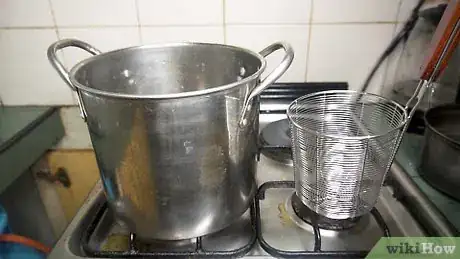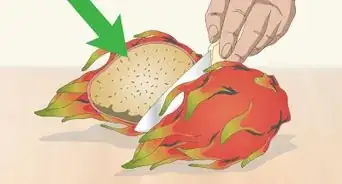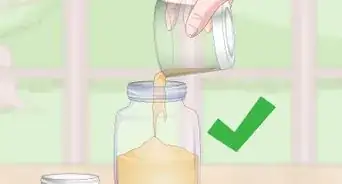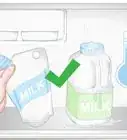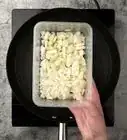This article was co-authored by Marrow Private Chefs and by wikiHow staff writer, Megaera Lorenz, PhD. Marrow Private Chefs are based in Santa Rosa Beach, Florida. It is a chefs’ collaborative comprised of an ever-growing number of chefs and culinary professionals. Though regionally influenced primarily by coastal, traditional southern, cajun, and creole styles and flavors, the chefs at Marrow have a solid background in all types of cuisine with over 75 years of combined cooking experience.
There are 8 references cited in this article, which can be found at the bottom of the page.
This article has been viewed 154,568 times.
Leeks are a flavorful onion relative that can make a tasty addition to soups, savory pies, and a variety of other dishes. But can you freeze leeks? With a little preparation, yes! You can freeze and store leeks for several months. Take care to clean your leeks well before freezing. You can also blanch them to help them stay fresh longer. Flash freeze your leeks and store them until you’re ready to use them.
Steps
Cleaning
-
1Remove any roots and excess green stems. Start by cutting off any roots at the base of your leeks (on the end of the white bulb), as well as the dark green part at the top. When you trim off the greens, leave some of the pale green stem above the white bulb at the bottom.[1]
- If you wish, you can save some of the darker green parts for flavoring soup stock or broth.[2]
-
2Rinse the outside of your leeks. Once your leeks are trimmed, give them a quick rinse with cool water to remove any obvious dirt and grime on the outside. Because of the way they grow, leeks tend to trap a lot of dirt and grit between their layers. Before you can freeze your leeks, you will need to clean them thoroughly.[3]Advertisement
-
3Cut your leeks into halves or quarters lengthwise. Place the leeks on a cutting board or plate and slice them lengthwise with a sharp knife.[4] If you like, slice each half lengthwise a second time to create quarters.
- If you wish, you may then chop the halved or quartered leeks into smaller crosswise sections.
-
4Rinse the cut leeks under running water. Take each section of sliced leek and rinse it under cool water. Gently spread apart the layers with your fingers to remove any trapped dirt and grit.
- If you chopped up your leeks, gently swirl them in a bowl of cool water instead. Once they’re rinsed, transfer them to a dry bowl using a slotted spoon.[5]
Blanching
-
1Get a large pot and a wire blanching basket. While you don’t have to blanch your leeks before freezing, doing so can help your frozen leeks stay fresher and more flavorful for longer.[6] You will need a large cooking pot and a blanching basket or pasta strainer.
- If you don’t have a blanching basket or strainer, a mesh cooking bag will also work.
- If you choose not to blanch your leeks, try to use them within 1 to 2 months after freezing.[7]
-
2Add water to the pot and bring the water to a boil. Put some water in the pan and set it on the range on high heat until it comes to a boil. Use 1 gallon (3.8 liters) of water for every pound (.45 kg) of prepared leeks.[8]
-
3Put the leeks in the blanching basket and lower them into the water. Fill your blanching basket, strainer, or mesh cooking bag with clean leeks that are cut or chopped. Place the blanching container and leeks in the water once it starts to boil.[9]
-
4Cover the pot as soon as the water returns to a boil. The water may stop boiling momentarily when you put the leeks into the pot. Wait for a moment for the water to begin boiling again, then immediately cover the pot.[10]
-
5Let the leeks sit in the boiling water for about 30 seconds. You will need to start timing from the moment the water begins boiling again.[11] Let your leeks sit covered in the pot with the cover on for at least 30 seconds, but no longer than 1-2 minutes.
-
6Remove the basket immediately and place the leeks in cold water for 1-2 minutes. Remove the leeks from the pot, let them drain, and quickly dump them into a bowl of cold water. The goal of blanching is to stop enzyme action in the vegetable without actually cooking it. In order to prevent cooking, you will need to immediately move the leeks into cold or icy water once they are done blanching.[12]
- Use water that is chilled or no warmer than 60° F (15.6° C).
- Let the leeks sit for a minute or 2 so that they have time to cool all the way through.
-
7Drain the leeks thoroughly and lay them out to air dry. Remove the leeks from the cold water and place them in a colander to drain.[13] Once they are drained, spread them out on a plate or baking sheet and allow them to air dry for a few minutes.
- You can also gently pat the leeks with a clean, dry kitchen towel to soak up any excess moisture.
- Freezing your leeks with too much moisture on them can reduce their quality and storage life.[14]
Freezing and Storing
-
1Spread your leeks on a sheet of wax paper on a baking sheet. Place a layer of wax paper or parchment paper on a baking sheet, and place your leeks on it in a single layer.[15] Don’t worry if the leeks touch each other a little, but don’t pile them up, or they may stick together or take longer to freeze.
-
2Put the leeks in your freezer for 30 minutes or until they are frozen. Place the tray full of leeks in your freezer and leave them for 20-30 minutes, then check to see if they are frozen. If not, give them some extra time.
- Gently feel the leeks to check that they feel hard and brittle to the touch. If they are still soft and flexible, leave them in the freezer a bit longer.
-
3Transfer the leeks to a freezer-safe container. Once the leeks are frozen, put them in a zipper-top freezer bag or other freezer-safe container. Make sure the container is tightly sealed. Squeeze as much air out of the container as you can.[16]
-
4Store leeks for up to 10-12 months in your freezer. If you store your leeks in a tightly sealed container and maintain your freezer at a consistent temperature of 0° F (-17.8° C) or lower, they will stay fresh for a long time.[17] Frozen leeks can stay good for up to a year.[18]
- Make sure to label your container with the date so you will know how long they have been frozen.
- Leeks that are improperly stored or frozen for too long will become mushy.
- If you did not blanch your leeks before freezing, you may notice a decrease in quality and flavor after 1 to 2 months.[19]
Community Q&A
-
QuestionCan I freeze uncooked leeks?
 wikiHow Staff EditorThis answer was written by one of our trained team of researchers who validated it for accuracy and comprehensiveness.
wikiHow Staff EditorThis answer was written by one of our trained team of researchers who validated it for accuracy and comprehensiveness.
Staff Answer wikiHow Staff EditorStaff AnswerYes, but they won’t keep as well as leeks that have been blanched (briefly cooked in boiling water) first. Blanching helps the leeks retain more of their flavor, color, and nutrients after freezing.
wikiHow Staff EditorStaff AnswerYes, but they won’t keep as well as leeks that have been blanched (briefly cooked in boiling water) first. Blanching helps the leeks retain more of their flavor, color, and nutrients after freezing. -
QuestionHow do you thaw frozen leeks?
 wikiHow Staff EditorThis answer was written by one of our trained team of researchers who validated it for accuracy and comprehensiveness.
wikiHow Staff EditorThis answer was written by one of our trained team of researchers who validated it for accuracy and comprehensiveness.
Staff Answer wikiHow Staff EditorStaff AnswerGenerally, you can cook leeks directly from the freezer. The heat from the cooking process will very quickly thaw them with little loss of flavor and texture. If you’d prefer to thaw them first, leave them out on your kitchen counter for about 1 hour before using them.
wikiHow Staff EditorStaff AnswerGenerally, you can cook leeks directly from the freezer. The heat from the cooking process will very quickly thaw them with little loss of flavor and texture. If you’d prefer to thaw them first, leave them out on your kitchen counter for about 1 hour before using them. -
QuestionCan you use frozen leeks for soup?
 wikiHow Staff EditorThis answer was written by one of our trained team of researchers who validated it for accuracy and comprehensiveness.
wikiHow Staff EditorThis answer was written by one of our trained team of researchers who validated it for accuracy and comprehensiveness.
Staff Answer wikiHow Staff EditorStaff AnswerYes, this is a great way to use frozen leeks! There’s no need to thaw them first, just put them straight into the pan. Lightly sauté the leeks in butter or olive oil along with other aromatics, such as garlic or onion, before adding them to the soup. This will bring out their flavor and aroma.
wikiHow Staff EditorStaff AnswerYes, this is a great way to use frozen leeks! There’s no need to thaw them first, just put them straight into the pan. Lightly sauté the leeks in butter or olive oil along with other aromatics, such as garlic or onion, before adding them to the soup. This will bring out their flavor and aroma.
Things You’ll Need
- Fresh leeks
- Cutting board
- Sharp kitchen knife
- Large pot
- Wire blanching basket, strainer, or mesh cooking bag
- A large bowl for rinsing and soaking your leeks
- Colander
- Baking sheet
- Wax or parchment paper
- Freezer-safe container or zip-top bags
References
- ↑ https://rediscover.co.nz/preparing-cleaning-and-freezing-leeks/
- ↑ https://www.foodnetwork.com/how-to/photos/how-to-clean-leeks
- ↑ https://www.simplyrecipes.com/recipes/how_to_clean_leeks/
- ↑ https://www.simplyrecipes.com/recipes/how_to_clean_leeks/
- ↑ https://www.simplyrecipes.com/recipes/how_to_clean_leeks/
- ↑ https://extension.umn.edu/preserving-and-preparing/vegetable-blanching-directions-and-times-home-freezer-storage
- ↑ https://www.motherearthnews.com/real-food/freezing/freezing-vegetables-zebz1309zstp
- ↑ https://extension.umn.edu/preserving-and-preparing/vegetable-blanching-directions-and-times-home-freezer-storage
- ↑ https://extension.umn.edu/preserving-and-preparing/vegetable-blanching-directions-and-times-home-freezer-storage
- ↑ https://extension.umn.edu/preserving-and-preparing/vegetable-blanching-directions-and-times-home-freezer-storage
- ↑ https://extension.umn.edu/preserving-and-preparing/vegetable-blanching-directions-and-times-home-freezer-storage
- ↑ https://extension.umn.edu/preserving-and-preparing/vegetable-blanching-directions-and-times-home-freezer-storage
- ↑ https://extension.umn.edu/preserving-and-preparing/vegetable-blanching-directions-and-times-home-freezer-storage
- ↑ https://www.eatright.org/homefoodsafety/four-steps/refrigerate/blanch-before-you-freeze
- ↑ https://extension.umn.edu/preserving-and-preparing/vegetable-blanching-directions-and-times-home-freezer-storage
- ↑ https://extension.umn.edu/preserving-and-preparing/vegetable-blanching-directions-and-times-home-freezer-storage
- ↑ https://extension.umn.edu/preserving-and-preparing/vegetable-blanching-directions-and-times-home-freezer-storage
- ↑ https://www.almanac.com/content/freezer-storage-times-how-long-can-you-freeze-foods
- ↑ https://www.motherearthnews.com/real-food/freezing/freezing-vegetables-zebz1309zstp
- ↑ https://www.thespruceeats.com/leek-selection-and-storage-1808073
